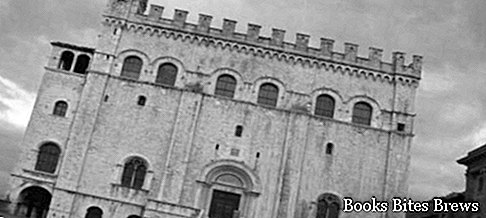What to see in Gubbio, itinerary including the main monuments and places of interest, including Palazzo dei Consoli, Roman Theater and Cathedral.
Tourist information
In the Umbria region in the province of Perugia, there is the city of Gubbio, which extends to the slopes of Mount Ingino, on top of which stands the Basilica of Sant 'Ubaldo, bishop and patron of the city.
To reach the top you can use, in addition to a panoramic road, a cable car that starts from the historic center, located at 550 meters above sea level, and reaches about 900 meters, at the point where the Basilica is located.
The first settlements in the Eugubino territory date back to prehistoric times, some findings and the numerous caves located on the sides of the mountain are testimony to this.
Around the second millennium BC, the ancient Umbrian people arrived in Italy, who settled in these lands, initially organizing themselves in small fortified villages built on top of the hills, then, between the tenth and ninth centuries BC, joining the city.
Ikuvium or Iguvium is one of these ancient places, whose archaeological site corresponds today to the city of Gubbio.
Unique and very important testimonies of this period are the Eugubine Tablets, which were discovered around the middle of the fifteenth century and purchased by the municipality in 1456.
These are seven bronze plates written in the Umbrian language and in the Latin alphabet, kept in the Palazzo dei Consoli.
Very flourishing center in Roman times, Gubbio was destroyed by the Goths and rebuilt by the Byzantines on the slopes of Mount Ingino, higher than the previous site where the remains of the Roman Theater are located today.
The city was a free municipality and went through various events, then from the thirteenth century to the middle of the fourteenth century, it grew considerably from an urban, economic and demographic point of view, important buildings were built such as the Cathedral, the Palazzo dei Consoli, and the Palazzo del Pretorio , also called "del Podestà".
In the fifteenth century Gubbio lost the title of free municipality, passing under the lordship of the Montefeltro, lords of Urbino.
Recommended readings- Umbria: Sunday day trips
- Gualdo Tadino (Umbria): what to see
- Ferentillo (Umbria): what to see
- Orvieto (Umbria): what to see
- Castiglione del Lago (Umbria): what to see
In this period the city benefited from a new cultural and artistic impetus, especially with Duke Federico da Montefeltro, a refined patron of the Renaissance, who had the Palazzo Ducale built, in imitation of the larger one in Urbino.
The lordship of the Montefeltro family followed that of the Della Rovere family, then the city was donated to the Papal States, to which it remained subject until the annexation of the Kingdom of Italy.
What see
The most important building in Gubbio is the Palazzo dei Consoli, whose facade faces towards Piazza Grande.
Built between 1332 and 1349, it is a true architectural gem, considered the only one that can compete with the Palazzo della Signoria in Florence.
From the early twentieth century, the Palazzo dei Consoli houses the Civic Museum and the Municipal Art Gallery, where the precious Eugubine Tables are kept.
The imposing Cathedral of Gubbio, built in place of a previous Romanesque church and dedicated to Saints Mariano and Giacomo, dates back to the thirteenth and fourteenth centuries, inside it there are important works by Renaissance artists.
In front of the Cathedral is the Palazzo Ducale, built after 1476 in Renaissance style at the behest of Federico di Montefeltro.
In this building, which is the result of the transformation and expansion of a core of medieval buildings, it is possible to visit the rooms on the ground floor, where there are fireplaces, architectural ornaments and a copy of Federico da Montefeltro's study, as the The original of the work is located in the Metropolitan Museum in New York.
On the slopes of Monte Ingino stands the Basilica of Sant 'Ubaldo built above the church where the body of the saint had been moved on 11 September 1194.
The church, documented from the thirteenth century, was restored in the first half of the sixteenth century, when the adjoining convent was built, entrusted to the Lateran Canons Regular.
In the Basilica are kept the candles of the Corsa dei Ceri, which takes place on May 15th of each year in honor of Sant’Ubaldo.
Other interesting churches are the churches of Santa Maria Nuova, San Francesco, San Domenico, San Giovanni, San Pietro and Sant’Agostino.
On the outskirts of the city there is the large Roman Theater, built at the end of the first century BC, which testifies to the importance reached by the city in Roman times.
The building, largely restored, retains the lower arches and part of the upper ones.
During the summer season, performances of classical shows are organized.
A tradition of this city is the large Christmas tree, which is illuminated on a slope of Mount Ingino during the Christmas period.
This luminous silhouette that reproduces the shape of a fir tree ended up in the Guinness Book of Records, becoming a symbol of the city.
Do not forget that the famous episode from the Fioretti di San Francesco is linked to the city of Gubbio, which tells of the ferocious wolf made meek by the Saint.




